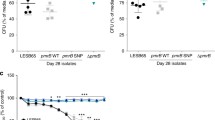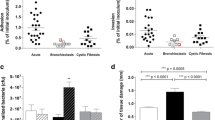Abstract.
Auxotrophic Pseudomonas aeruginosa are exclusive to respiratory infections in cystic fibrosis (CF) and bronchiectatic patients, and isolates require specific amino acids for growth on minimal media, particularly methionine. Since auxotrophic and prototrophic P. aeruginosa from CF are identical by genotyping, we investigated the genetic events leading to methionine auxotrophy (Met−). Most (10/13) Met− strains had the same pattern of growth on methionine precursors and required methionine exclusively for growth. Back mutation to prototrophy was very low (frequencies 10−8 to <10−10). Complementation of the mutations leading to auxotrophy was achieved for five strains with a genomic library of P. aeruginosa PAO1. Strains with different patterns of growth on methionine precursors were complemented by clones with different restriction patterns, while identical clones complemented strains with the same pattern of growth on methionine precursors. Methionine auxotrophy in P. aeruginosa from CF results from stable chromosomal mutations, and the commonest defect is probably in gene(s) encoding enzymes that convert homocysteine to methionine.
Similar content being viewed by others

Author information
Authors and Affiliations
Additional information
Received: 2 August 1997 / Accepted: 23 September 1997
Rights and permissions
About this article
Cite this article
Barth,, A., Woodford, N. & Pitt, T. Complementation of Methionine Auxotrophs of Pseudomonas aeruginosa from Cystic Fibrosis. Curr Microbiol 36, 190–195 (1998). https://doi.org/10.1007/s002849900292
Issue Date:
DOI: https://doi.org/10.1007/s002849900292



